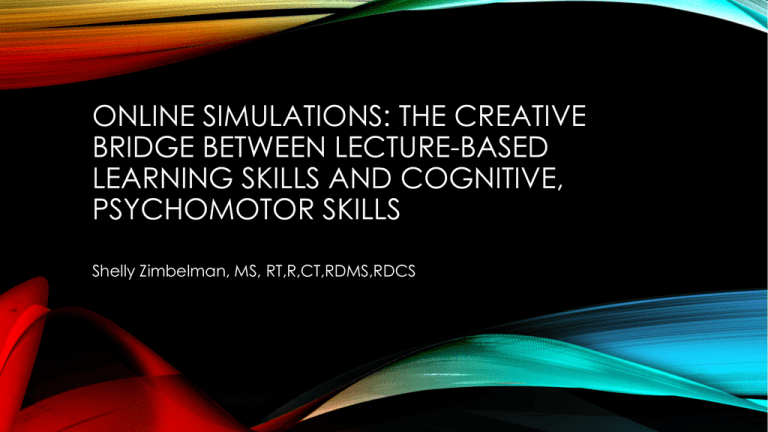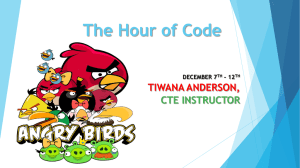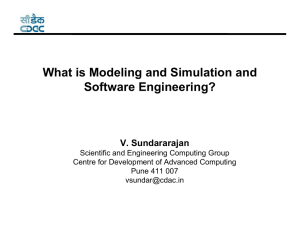online simulations: the creative bridge between lecture
advertisement

ONLINE SIMULATIONS: THE CREATIVE BRIDGE BETWEEN LECTURE-BASED LEARNING SKILLS AND COGNITIVE, PSYCHOMOTOR SKILLS Shelly Zimbelman, MS, RT,R,CT,RDMS,RDCS TARGET AUDIENCE Individuals with an interest in improving competency and skilled-based learning through Online Simulations • Institutional Leaders • Program Directors • Instructors • Clinic Instructors • Publishers • Manufacturers • YOU? OBJECTIVES • Review of Learning Styles • Outline of how learning retention occurs • Overview of types of Simulations • Demonstration of the added Value of Simulations in the classroom • Overview of the value of Online Learning • Overview of the Value of Online Simulations • Examples of Online Simulators • Wrap-up WHAT IF? How many of you have tried a new recipe? How did you learn the recipe? • • • • Written recipe Watched a video demonstration Someone taught you hands on Trial and error What if you had a short online simulation that allowed you to: • • • • Practice mixing ingredients Practice using different portion sizes Practice with gas vs. electric stove and different cooking ware types Test the effects of choosing to use varied cooking times and temperatures and see the results from your choices before actually beginning any steps for cooking Why would this be useful? • Recognition of utensils • Understanding of step-by-step process • Recognition of results from choices • Reduced stress • Reduced cost • Reduced time • Increased Skill-set Tokyo Institute of Technology FOOD FOR THOUGHT I See and I Forget I Hear and I Remember I DO and I Understand Confucius LEARNING STYLES Bloom’s Taxonomy (2001) Create Evaluate Analyze Apply Understand Remember Learning Styles Auditory Visual Kinesthetic RETENTION Reading Hearing Words Seeing Watching a Movie Looking at an Exhibit Watching a Presentation Seeing it done on location Participating in a Discussion Giving a Talk Doing a Dramatic Presentation CONE OF LEARNING 10% of what we read 20% of what we hear 30% of what we see 50% of what we see and hear 70% of what we say 90% of what we say and do Simulating the Real Experience Doing the Real Thing Edgar Dale (1969) COGNITIVE LEARNING • Learning that is concerned with acquisition of problem-solving abilities and with intelligence and conscious thought • Theory that defines learning as a behavioral change based on the acquisition of information about the environment Mosby’s Medical Dictionary, 8th edition, 2009 COGNITIVE LEARNING PATH AND SIMULATIONS Unaware Low Level Interest Student •Don’t know what we don’t know •Unconscious Incompetent •Know that we don’t know •Conscious Incompetent •Ineffective Learning •Knowledge Begins Entry Level Practitioner •Know that we know •Developing Skill-set •Conscious Competent Expert Master •Experienced •Comfortable with skill-set •Knowledge is Rooted •Natural skill-set •Unconscious Competent COURSE DESIGN/ADDIE MODEL Analyze Design Develop Implement Evaluate Pre-planning; thinking about the course Design your course on paper Develop course materials and assemble the course Begin Teaching Look at the course outcomes with a critical eye •Design of course •Audience •Goal •Objectives •Identify contnet •Identify Environment and Delivery •Instructional Strategies •Assessment Strategies •Formative Evaluation •Constraints •Name the learning units of Instruction •Identify content and strategies for an individual unit of instruction •Write instructions for the learning unit •Name the menu items for a learning module •Based on design phase •Build content, assignments, assessments •Build course structure •Upload content •Overview of course •Expectations •Initiate instruction •Interaction •Ask for feedback early on (formative evaluation) •Did the students achieve expected learning outcomes? •What have you learned? •How can you make the course better? TYPES OF SIMULATIONS DEFINITION Definition The reproduction of essential features of something, e.g. as an aid to study or training (EncartaDictionaries) Medical Simulation The modern day methodology for training healthcare professionals through the use of advanced educational technology. Simply put, medical simulation is the experiential learning every healthcare professional will need, but cannot always engage in during real-life patient care. (Healthy Simulation) Derived from Aviation Simulation (Used since WWI) • Simulation allows for the safe training of learners engaging in activities that would otherwise be too dangerous to practice. • Simulation also allows for more practice time Group (Physical) Facility Online Virtual Mock Trial Physical Equipment E-Learning Simulation VALUE OF SIMULATIONS • Learning to achieve an outcome based on experience • Experiential learning • Higher Retention • Mistakes are “learning experiences” without high cost • Less patient related injuries or inadequate care • Less injuries to students and personnel • Reduction in damaged equipment • Constant, Consistent feedback • Make corrections before real world interactions • Enjoyable • Increased Retention • Capstone for training certification and competency readiness PERCEPTION Lab and Clinical Throughout the nation there is a common question of how lab and clinical time can be provided via simulation in the institutional setting. This question traverses multiple fields/programs. Simulations • Traditionally, the “gold standard” has been that hands-ons training should occur solely in the lab and clinical setting. • Therefore, any substitution to this, is a threat to the quality of graduate education and ultimately patient care. REALITY Ironside and McNeils, in press • Recent National Survey of Nursing Faculty • Barriers exist with lack of quality clinical sites and lack of qualified instructors • Causing the usage of alternatives to meet training needs Affects • Sending students to “observe” • Grouping students during care of a single patient • Decrease in number of skills/procedures a student learns • Increase of simulation usage Tanner (2006a) • Current Clinical Model • One Clinical Preceptor to a group of students • Treating a couple of patients each • Same model traced back to 1930 • Hospitals are growing more concerned about new graduates • Clinical education is increasingly lacking and will continue to plummet if the traditional, decades old model is not modernized ONLINE LEARNING • Allows for a flipped classroom • Allows the student freedom to learn anywhere • Allows for hybrid classrooms and programs • Reach an extended audience ONLINE SIMULATIONS • Engages learners in solving sequential procedures or problems • Encourages learners to apply newly retained knowledge to appropriate situations • Relates information to previous experiences • Demonstrates information through interactive and creative step-by-step scenarios or activities • Requires learners to use gained knowledge to solve a problem • Increases the rate of competency-based learning EXAMPLES EXAMPLE ONE • Medical Surgeries EXAMPLE TWO • SIMTICS REVIEW • Identified Gap from Cognitive Learning to Clinical Practice • Simulations are a perfect fit for this gap • Simulations include all three learning styles • Retention increases with simulation usage • Competency increases with simulation usage REFERENCES • Theory Into Practice, Anderson, Krathwohl, et al., 41 no4, 2002 • Anderson, L.W., Krathwohl, D.R., Airasian, P.W., Cruikshank, K.A., Mayer, R.E., Pintrich, P.R., Raths, J., Wittrock, M.C. (2001). A Taxonomy for Learning, Teaching, and Assessing: A revision of Bloom's Taxonomy of Educational Objectives. New York: Pearson, Allyn & Bacon. • Bloom, B.S. (Ed.). Engelhart, M.D., Furst, E.J., Hill, W.H., Krathwohl, D.R. (1956). Taxonomy of Educational Objectives, Handbook I: The Cognitive Domain. New York: David McKay Co Inc. • Ironside, P.M., McNelis, A.M. (2010). Clinical education in prelicensure nursing programs: Results from an NLN National Survey 2009. National League for Nursing, New York • The Future of Nursing: Leading Change, Advancing Health (Institute of Medicine, 2011) • James, W.; Gardner, D. (1995). "Learning styles: Implications for distance learning". New Directions for Adult and Continuing Education 67. • Citation: Huitt, W., & Hummel, J. (2003). Piaget's theory of cognitive development. Educational Psychology Interactive. Valdosta, GA: Valdosta State University





